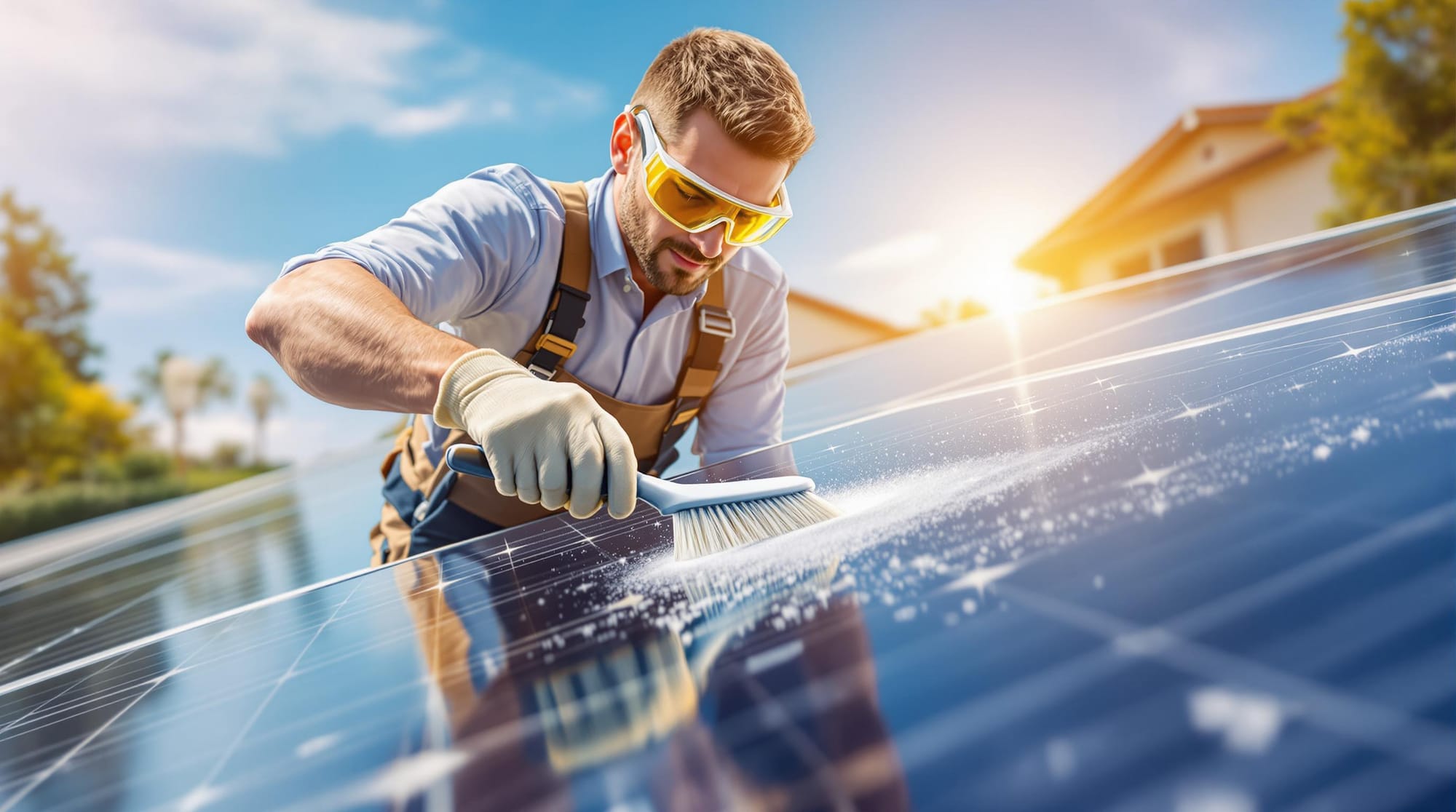How to Safely Clean Solar Panels at Home
Learn how to safely clean solar panels at home to maximize efficiency, protect your investment, and extend their lifespan.

Want maximum efficiency from your solar panels? Keep them clean. Dirt, dust, and debris can block sunlight, reducing energy output and lifespan. Cleaning solar panels is simple and safe if you follow these key steps:
- Turn off the system: Power down AC and DC disconnects to avoid electrical risks.
- Choose the right time: Clean in the early morning, late evening, or on overcast days when panels are cool.
- Use proper tools: Soft-bristled brushes, microfiber cloths, and deionized water prevent damage.
- Avoid harsh methods: Skip pressure washers, abrasive sponges, and strong chemicals like bleach or ammonia.
How often should you clean? Every 3–6 months, depending on your environment. Regular cleaning improves energy production, protects your warranty, and extends panel life. If accessing your roof is unsafe, hire a professional. Clean panels mean better performance - simple as that.
How to Clean Solar Panels THE RIGHT WAY
Safety Checklist Before Cleaning
Take the necessary precautions to protect both yourself and your solar panels during cleaning.
Power Down Your System
Shutting down your solar system properly is a must for your safety:
- Check your manual: Refer to the system's documentation for detailed shutdown instructions.
- Turn off AC disconnect: This is typically located near your inverter or electrical panel.
- Turn off DC disconnect: Usually positioned next to the inverter.
- Wait 5 minutes: Allow time for the system to fully discharge.
Check Roof Safety
If you need to access your roof, ensure you're prepared with the right equipment and precautions:
- Weather conditions: Make sure the roof is completely dry, and no rain is expected.
- Safety harness: Use OSHA-approved fall protection gear when working above 6 feet.
- Stable footing: Wear non-slip shoes to reduce the risk of slipping.
- Support system: Have someone on the ground to assist or monitor.
- Accessibility check: If your roof is very steep (over a 35° angle) or higher than 20 feet, it's safer to hire a professional.
For single-story homes, you can often clean panels from the ground using extension tools. This approach avoids the risks associated with climbing onto the roof while still achieving effective results.
Best Times to Clean
Choosing the right time to clean ensures better safety and efficiency:
| Time of Day | Benefits | Considerations |
|---|---|---|
| Early Morning | - Panels are cool - Less water evaporation - Better visibility |
Check for morning dew |
| Late Evening | - Cooler temperatures - Reduced glare |
Ensure adequate lighting |
| Overcast Days | - Lower risk of thermal shock - Comfortable working conditions |
Confirm no rain is expected |
Temperature tip: Avoid cleaning panels when they are hotter than 100°F (37.8°C). Applying cool water to hot panels can cause the glass to crack. Test the surface using the back of your hand - if it feels too hot, wait for a cooler time.
Plan to clean during low-production hours, allowing about 1–2 hours for the task. Adjust how often you clean based on your local climate and pollution levels.
Once you're ready and safety measures are in place, gather your cleaning tools to get started.
Required Cleaning Equipment
Having the right tools is key to keeping your panels in good shape while protecting your investment.
Safe Cleaning Tools
Choose gentle tools to avoid damaging your panels. Here’s what you’ll need:
- Soft-bristled brush: Opt for a split-tip brush similar to those used for washing cars.
- Microfiber cloths: High-quality microfiber cloths help avoid scratches and leave no residue. Keep a few handy for different cleaning steps.
- Squeegee: Use a rubber-edged squeegee with a soft frame to remove water without scratching.
- Bucket: A 5-gallon bucket works well for mixing cleaning solutions and rinsing tools.
Safe Cleaning Solutions
Stick to mild cleaning agents that won’t harm your panels’ coating. Here are some recommended options:
| Cleaning Solution | Best Use Case | Notes |
|---|---|---|
| Deionized Water | Regular cleaning | Prevents mineral spots |
| Mild Dish Soap | Tough dirt | Mix 1 teaspoon per gallon of water |
| Isopropyl Alcohol | Bird droppings | Use a 10% solution with water |
Important: Avoid abrasive cleaners, vinegar-based solutions, or chemical glass cleaners, as these can damage the anti-reflective coating on your panels.
Long-Reach Tools
For hard-to-reach areas, invest in quality extension tools:
- Telescopic pole: Choose one that extends between 12 and 24 feet, depending on your roof height and panel layout.
- Water-fed pole system: This combines a water supply with cleaning attachments. Look for models with built-in water filters.
- Extension attachments: Accessories like quick-release connectors, angle adapters for better reach, and lightweight pole sections can make the job easier.
For single-story homes, a 12–16 foot pole is usually enough, while multi-story homes may require a 20–24 foot extension.
Dedicate your cleaning tools solely to solar panel maintenance to avoid contamination. Store them in a clean, dry place to keep them in good condition and extend their lifespan.
4 Steps to Clean Solar Panels
Here’s how to clean your solar panels safely and effectively.
Check Panel Condition
Start by inspecting your panels for any issues:
- Look for visible cracks, loose connections, or damaged areas.
- Check for heavy dirt, bird droppings, or tree sap.
- Examine the seals around the panel edges for signs of wear.
- Take photos of any areas that seem problematic.
Tip: If accessing the roof is difficult, use binoculars from the ground for an initial inspection.
Initial Water Rinse
Begin with a gentle rinse to clear away loose debris:
- Use deionized water at standard hose pressure.
- Start from the top of the panels and work downward.
- Hold the hose at a 45° angle.
- Keep the nozzle about 4-5 feet away from the panels.
- Ensure the water flows evenly across the surface.
Clean Tough Spots
For stubborn dirt, use the right approach:
| Debris Type | Cleaning Method | Time Needed |
|---|---|---|
| Dust/Pollen | Soft brush with water | 30-60 seconds |
| Bird Droppings | Soak with solution, gentle brush | 2-3 minutes |
| Tree Sap | Isopropyl solution, microfiber | 1-2 minutes |
Apply a cleaning solution with a soft brush, using gentle circular motions. Avoid pressing too hard. Work on small sections, about 3x3 feet at a time. Once the tough spots are cleaned, rinse thoroughly to remove all residue.
Final Rinse and Dry
Finish the process with these steps:
- Rinse each panel thoroughly with deionized water.
- Use a squeegee at a 30° angle to remove excess water.
- Work from top to bottom in a systematic way.
- Allow the panels to air dry completely before turning the system back on.
- Avoid cleaning during peak sunlight to prevent water spots.
Note: If water beads instead of flowing smoothly during the final rinse, it means there’s leftover soap that needs to be rinsed off again.
For the best results, clean your panels in the early morning or late afternoon when they’re cool to the touch. This helps prevent quick evaporation and avoids leaving mineral deposits.
What Not to Do
Taking care of your solar panels involves more than just cleaning them - it’s about avoiding mistakes that could cause long-term damage. Here’s what to keep in mind to protect your investment.
Avoid Harsh Tools or High-Pressure Equipment
Using the wrong tools or equipment can ruin your solar panels' protective coating. Stay away from:
- Pressure washers: Even on low settings, they can crack the glass or damage seals by causing tiny fractures that worsen over time.
- Metal brushes: Steel wool or wire brushes can scratch the glass surface.
- Abrasive sponges: Rough pads can leave small scratches that trap dirt and reduce efficiency.
Stick to soft microfiber cloths, gentle brushes with natural bristles, and a garden hose with moderate water pressure. Choosing the right cleaning agents is just as important.
Avoid Strong Cleaning Products
Certain chemicals can break down the materials on your solar panels, leading to problems. Here’s a quick guide:
| Cleaning Product | Why to Avoid | Potential Damage |
|---|---|---|
| Bleach | Corrosive to seals | Can cause edge failure |
| Ammonia | Leaves residues | Reduces light absorption |
| Vinegar | Too acidic | May etch the surface |
| Undiluted dish soap | Leaves a film | Can lower performance |
Instead, use deionized water or pH-neutral cleaning solutions specifically designed for solar panels. These options clean effectively without causing harm.
Don’t Walk on the Panels
Solar panels aren’t made to handle the weight of a person. Walking on them can:
- Cause stress fractures in the glass
- Bend the mounting frame
- Damage internal connections
- Void your warranty
Even light pressure can lead to hidden damage. Use extension tools and clean from the edges or a stable platform nearby to avoid stepping on the panels.
Safety Tip: If you can’t reach all parts of your solar panels safely, consider hiring a professional cleaner. The cost of professional cleaning is often far less than repairing or replacing damaged panels.
When to Clean Your Panels
Timing your solar panel cleanings is key to keeping them efficient and minimizing maintenance efforts. Your local environment largely determines how often you should clean them.
Cleaning Timeline
Here’s a quick guide to cleaning frequency based on where you live:
| Environment Type | Recommended Cleaning Frequency | Key Factors |
|---|---|---|
| Urban/Suburban Areas | Every 3-4 months | Air pollution, bird droppings |
| Rural Areas | Every 6 months | Pollen, dust, leaves |
| Desert Regions | Every 2-3 months | Sand, dust storms |
| Areas Near Trees | Every 2-3 months | Sap, leaves, bird activity |
| Coastal Areas | Every 2 months | Salt spray, marine residue |
For most suburban homeowners, cleaning every three months strikes a good balance. However, you may need extra cleanings after:
- Strong storms that leave debris
- Long dry spells without rain
- Nearby construction creating dust
- Heavy pollen seasons
- Increased bird activity
These factors can quickly impact performance, so adjust your schedule as needed.
Check Power Output
Regularly checking your system’s energy production ensures your cleaning schedule is effective and helps identify when extra cleaning is necessary. Most modern solar setups include monitoring tools to track daily performance.
Daily Performance Check
- Look at energy output between 10 AM and 2 PM.
- Compare current output to averages from previous months.
- Watch for gradual declines in production.
Signs Your Panels Need Cleaning
- A sudden 10–15% drop in output on clear, sunny days.
- Visible dirt or debris when viewed from the ground.
- Uneven performance across different panels.
- Consistent underperformance compared to seasonal averages.
Note: Solar production naturally dips in winter, often 30–40% lower than summer levels. Don’t confuse these normal seasonal changes with dirt-related issues.
Set reminders for regular inspections and cleanings based on your area’s conditions. Staying proactive prevents stubborn grime from building up, saving you from tougher cleaning jobs later on.
Conclusion: Clean Panels Work Better
Keeping your solar panels clean ensures they perform at their best and protects your investment. Clean panels produce more energy and have a longer lifespan.
Here are a few tips to keep in mind:
- Clean during cooler morning hours to avoid sudden temperature changes that could damage the panels.
- Use soft-bristled brushes and cleaning solutions that are safe for solar panels.
- Check energy output regularly to confirm that cleaning is effective.
- Avoid stepping on panels or using high-pressure washers, as this can cause damage.
- Always use proper safety gear when working at heights.
By following these steps, you can maintain your panels' performance and prevent potential long-term issues. Regular upkeep using the correct tools and methods helps ensure maximum energy production.
If you encounter persistent problems or can't safely access your panels, it's a good idea to contact a certified solar professional. The cost of professional cleaning is minimal compared to the benefits of well-maintained panels and improved safety.
Keep an eye on your cleaning schedule and energy output to adjust your routine as needed. With the right care, your solar panels will deliver top performance for years to come.

